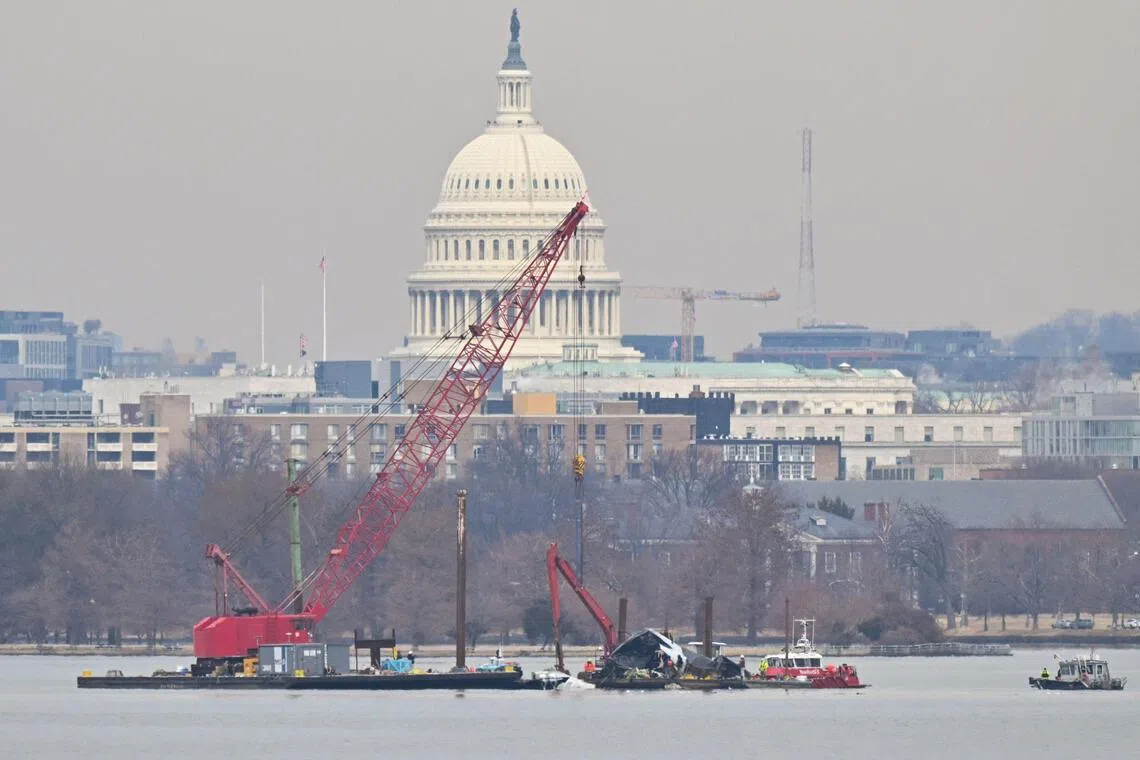First lawsuit filed over plane-helicopter crash in Washington
Sign up now: Get ST's newsletters delivered to your inbox

A crane on Feb 3 retrieving wreckage from the plane that had collided with a US Army helicopter in Washington.
PHOTO: AFP
Karoun Demirjian
Follow topic:
WASHINGTON – The widow of a passenger killed when an American Airlines plane collided with an Army helicopter
“The crash of American Eagle 5342 was predictable, it was preventable and caused the needless loss of 67 lives on that fateful evening,” said Mr Robert Clifford, a lawyer for the family of Mr Casey Crafton, an aviation technician from Connecticut and father of three who was on the plane.
Mr Clifford announced the suit against the affiliated airlines and the federal government at a news conference.
In the suit, Mr Clifford and his team said that the airlines and federal government “knew, or should have known” that the airspace around Reagan National Airport presented safety risks that needed to be mitigated but were not.
Dozens of the families who lost loved ones in the Jan 29 crash have filed federal claim forms, a necessary step before suing the US government.
While the Crafton suit is the first related to the crash, lawyers and other victims’ relatives said during the news conference on Sept 24 that more would follow, noting that they were already coordinating their efforts.
They expected that the cases would ultimately be bundled together as they made their way through what could be a years-long court process.
“Many of us have been asked whether we dread rehashing the worst days of our lives in court. Our answer is clear: We’re ready,” Mr Doug Lane said. His wife, Christine, and son Spencer, 16, were killed in the crash on their way home from a figure skating competition.
In the 115-page complaint, filed in the US District Court for the District of Columbia, lawyers for the family of Mr Crafton argued that American Airlines and PSA Airlines, which was operating the commercial flight from Wichita, Kansas, to Washington, had failed to properly train pilots about helicopter routes near National Airport and ignored a pattern of documented near-misses in the area.
They also blamed the pilots of the commercial jet for failing to take precautions that might have averted disaster.
In a statement, American Airlines said it would “defend American and PSA Airlines against any legal action claiming the airline caused or contributed to this accident.”
It also said it supported the investigation by the National Transportation Safety Board, which is expected to deliver a final report on the crash by the end of January 2026.
In a statement, Mr Tim and Mrs Sheri Lilley, the parents of Mr Sam Lilley, 28, a pilot on Flight 5342, said: “Everyone who lost a loved one in the Jan 29 accident has the right to pursue the path they feel is best. We respect those choices while standing united in the shared goal of making sure no family ever suffers through such a preventable tragedy again.”
The lawsuit also targets the Federal Aviation Administration (FAA) and the Army, accusing the FAA of creating an inherently risky airspace around National Airport and allowing policies that routinely left the control tower inadequately staffed.
It accuses the controller on duty of failing to issue clear instructions or a formal safety alert ordering the aircraft to immediately change course.
The suit accuses the Army of failing to train its helicopter pilots to operate safely in the area, particularly at night, and charges that its pilots acted recklessly
Representatives for the Army and the Justice Department, which represents the federal government in such lawsuits, did not immediately respond to requests for comment.
A spokesperson for the FAA said that since the accident, the agency had “acted decisively to make the skies over our nation’s capital safer.”
The lawsuit comes less than two months after the transportation safety board held marathon hearings that highlighted the frequency with which Army helicopters flying along routes that traversed the airspace around Reagan National Airport would come into proximity with planes landing on Runway 33, and the often dicey manoeuvres each adopted to avoid crashes.
The hearings also revealed tensions within the FAA’s air traffic operation, illustrating how managers sidelined internal appeals to change helicopter routes and address staffing issues that ended up being factors in the Jan 29 crash.
Victims’ families said on Sept 24 that while the hearings had been important, their focus on government entities and not the airlines themselves had been “a point of frustration”.
“Yes, they were in a situation that they shouldn’t have been in, but they have a duty to crunch numbers, look at data and be proactive about preventing things like this from ever happening,” Mr Lane told reporters. NYTIMES

